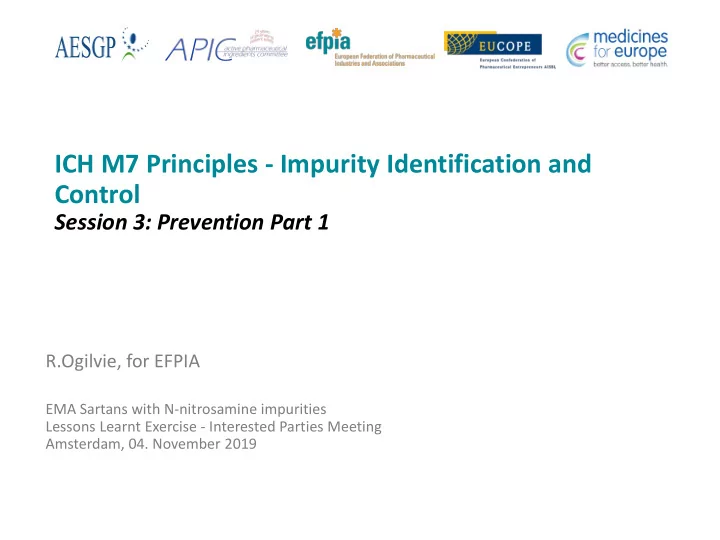

ICH M7 Principles - Impurity Identification and Control Session 3: Prevention Part 1 R.Ogilvie, for EFPIA EMA Sartans with N-nitrosamine impurities Lessons Learnt Exercise - Interested Parties Meeting Amsterdam, 04. November 2019 1
ICH M7: Assessment and control of DNA reactive (mutagenic) impurities in pharmaceuticals to limit potential carcinogenic risk Framework for a science based control of mutagenic impurities • N -Nitrosamines explicitly in scope as part of ‘cohort of concern’ • Multidisciplinary Guideline • Application of scientific principles from multiple disciplines incl. e.g., Process Chemistry, Analytical Chemistry, Toxicology • Globally accepted framework for the assessment and control of mutagenic impurities • Risk-based quality management (ICH Q9) Mutagenic Impurities: ICH M7 (R1) https://ich.org 2 https://database.ich.org/sites/default/files/M7_R1_Guideline.pdf
Global Regulatory Framework for Impurities: N -Nitrosamines are a subset of the cohort of concern and are within the scope of ICH M7 • ICH M7 principles are in Organic Impurities (ICH Q3A/B) (2002/2003) place to be applied, and are appropriate to be applied, to the ‘cohort of concern’ Mutagenic Impurities (ICH M7) (2014) impurities. • Potent ‘cohort of concern’ impurities need to be Cohort of concern controlled to lower levels than general M7 threshold Nitrosamines of toxicological concern 3
ICH M7 provides a science and risk based approach to mutagenic impurity control Impurity control Impurity Impurity to assure Identification classification suitable safety • • Process-related Impurities Known mutagenic Control through Process • Actual Impurities carcinogens (PDE) Design • • • Potential Impurities Known mutagens, Control through in • Predicted byproducts unknown carcinogenic process or intermediate Degradation Products potential (TTC) testing • • • In Drug Substance Alerting structures (TTC) Control through analytical • • In Drug Products Impurities free of testing of API predicted mutagenicity (not needing low level controls) Expert review of Expert evaluation and Process design, control toxicology data and analytical data strategy and testing predictive software 4
ICH M7 (+ other ICH expectations) applies to Development, and Medicine Supply to Patients post approval • ICH M7: Mutagenic impurity management expectations. Including evaluation of changes to manufacturing for impact on the quality of drug substance and drug product. Process and controls assessed at approval and through subsequent change. • Other ICH Impurity Guidances • Q3A and B - Impurity management expectations for non-mutagenic impurities • Q3C – residual solvents; Q3D elemental impurities • ICH Q9: Quality risk management • Evaluation of risks to quality based on scientific knowledge, to protect the patient • The Quality risk management process expected to be commensurate with the risk. • ICH Q7 – GMP • Good Manufacturing Practices • ICH Q10: Quality system - Science-based and risk-based approaches throughout lifecycle of product and its manufacture 5
Sartans learnings provide new understanding of root causes - M7 risk assessment using this knowledge could identify the potential for nitrosamine formation in API manufacturing Reagent Sodium nitrite NDMA Dimethylamine Nitrosamine formation Impurity formed from solvent ICH M7 expectations + Learnings support one another 6
Science-based approaches for mutagenic impurity risk assessment and management remain foundational • ICH M7 guideline provides the internationally-harmonised framework for identification, classification and control of mutagenic impurities • Control of mutagenic impurities can be achieved by e.g., • Controls on ingoing materials • In-process and intermediate testing during manufacture • Release testing of APIs • GMP-controls incl. prevention of cross-contamination • Impurity prediction and identification is based on expert knowledge and understanding of chemistry (impurity formation and removal) • N-nitrosamines formation during production of certain sartans can be predicted once the risk factors are identified as present • Standard nitrite treatment after sartan ring formation can nitrosate a vulnerable amine (hydrolytic impurity in reaction solvent) • This risk is now fully appreciated by industry and regulators 7
Recommend
More recommend